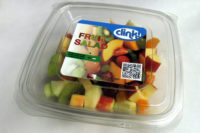E-commerce in the grocery retail market still has a lot of room to grow. According to the recent Nielsen New Retail Survey, half of global consumers polled said they were willing to buy groceries online, but only one-quarter already does.
Nonetheless, Amazon’s reported development of a drive-thru grocery store concept this summer was viewed as possibly being the company’s next big innovation. Additionally, the Hershey Company announced its Ice Breakers brand can now be ordered with an Amazon Dash Button.
For a number of years, direct to consumer has been identified as a potential future trend, but when it does ramp up, how will it impact food packaging?
“From a packaging perspective, there are several challenges with home delivery, particularly of products that are heavy [beverages] or susceptible to damage [fruits and vegetables],” says Todd Bukowski, senior packaging consultant for HAVI Global Solutions. “Food companies are accustomed to developing packaging specific to the sale of their products in drug, grocery and club stores, but less accustomed to developing packs specifically for e-commerce.”
He says this could change the way brands develop and package their food and beverages. For instance, concentrates may become more popular to reduce the water content being shipped, and package sizes might become smaller to take up less space on trucks and in storage. Plus, packaging for produce may need to have a more rigid format to provide protection and greater temperature control.
“As online food buying increases, brand owners will need to design stronger, more effective primary packaging that protects product without increasing packaging waste,” Bukowski says.




